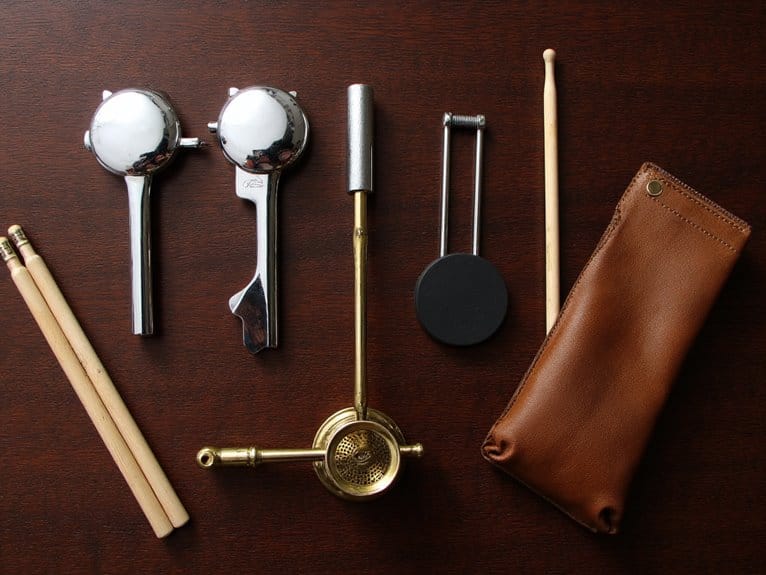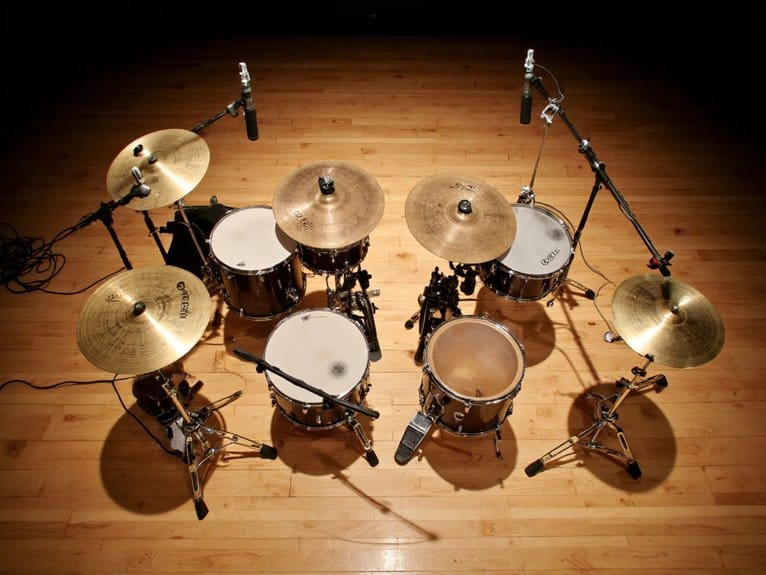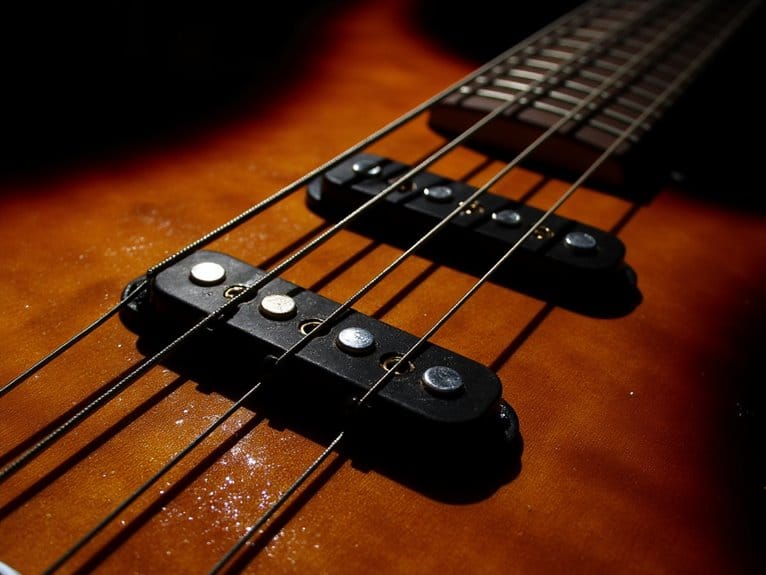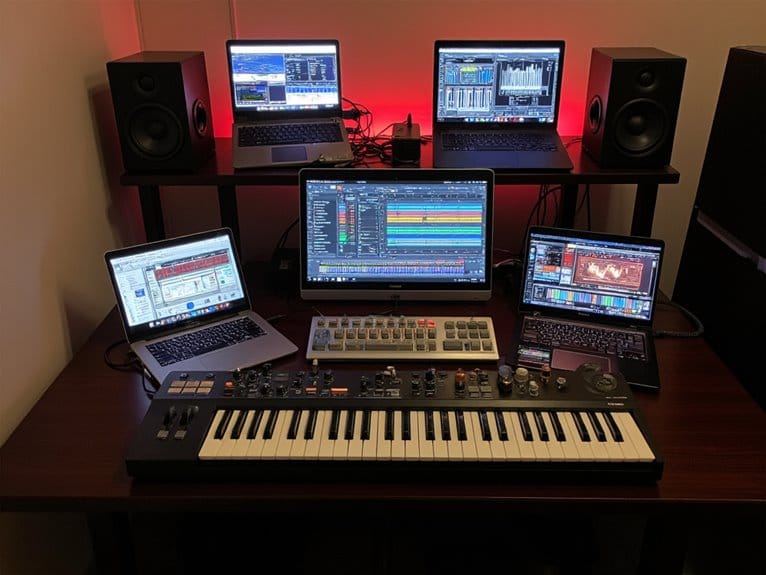Must-Have Drum Tools and Accessories
You’ll need quality drum keys and tension meters for precise tuning, protective cases ranging from soft padded options to ATA-rated hard shells for transport, and practice pads with realistic feel for quiet home sessions. Essential comfort items include ergonomic thrones with lumbar support, anti-fatigue mats, and musician-specific earplugs that preserve audio fidelity. Don’t overlook wearable metronomes for timing accuracy, sound dampening gels for overtone control, and basic tools like screwdrivers for hardware maintenance—though this barely scratches the surface of what transforms amateur setups into professional-grade configurations.
We are supported by our audience. When you purchase through links on our site, we may earn an affiliate commission, at no extra cost for you. Learn more.
Notable Insights
- Quality drum keys and tension meters are essential for precise tuning and maintaining even pressure distribution across drum heads.
- Protective cases ranging from soft padded cases to ATA-rated hard cases safeguard equipment during transport and storage.
- Practice pads and electronic metronomes enable quiet home rehearsals while developing timing precision and muscle memory.
- Basic maintenance tools including screwdrivers, Allen wrenches, and soft cleaning cloths extend equipment longevity through proper care.
- Ergonomic thrones with adjustable backrests and anti-fatigue mats improve comfort and posture during extended playing sessions.
Essential Tuning Tools and Hardware Maintenance
Most drummers I’ve encountered, including myself in my early years, underestimate the critical role that proper tuning tools play in achieving consistent, professional sound quality.
Proper tuning tools are the foundation of professional drum sound that most drummers overlook in their early development.
You’ll need a quality drum key as your foundation, though I’d recommend investing in specialized variants like torque keys for precise tension control, particularly if you’re serious about your tuning techniques.
Don’t overlook basic screwdrivers and Allen wrenches either, since hardware upkeep requires regular attention to lugs, tension rods, and cymbal stands. When tightening tension rods, always work in a diagonal pattern to ensure even pressure distribution across the drum head.
I’ve learned that applying lubricants to moving parts prevents stripping while ensuring smoother adjustments, and frankly, a tension meter can save you considerable time when equalizing pressure across drum heads for ideal pitch stability. Just as drummers benefit from cold-forged construction in cymbals for enhanced durability, your hardware components require similar attention to build quality and regular maintenance. For drummers looking to incorporate electronic elements, consider adding drum triggers to your arsenal for blending acoustic and electronic sounds seamlessly. Keep two drum keys on hand to prevent the frustration of loss and damage during critical maintenance sessions.
Professional drum miking also requires careful consideration of polar patterns when positioning microphones around your kit to minimize bleed from surrounding instruments.
Protective Cases and Transport Solutions
While proper tuning tools keep your drums sounding their best, protecting that investment during transport requires an entirely different set of considerations.
I’ll admit I learned this lesson the hard way after watching a friend’s snare drum bounce down concrete steps at a venue.
Your choice between soft cases and hard cases depends entirely on your transport safety needs and budget constraints, with case materials playing a vital role in determining protection levels. Many professionals opt for cases with EPDM rubber gaskets that provide enhanced protection against moisture and humidity damage during transport.
- Soft cases work perfectly for local gigs, offering lightweight nylon construction with padded interiors.
- Hard cases utilize polyethylene or ABS plastic shells for serious touring protection.
- ATA-rated drum trunks provide maximum security with reinforced aluminum edges and locking mechanisms.
- Specialized foam inserts prevent drum movement during transit, eliminating potential damage from impacts.
Timing and Practice Enhancement Devices
How do you develop the rock-solid timing that separates amateur drummers from professionals? The answer lies in consistent practice with specialized timing enhancement devices that transform your practice sessions into precision-building workshops.
Practice pads form the foundation of effective timing development, offering tunable surfaces that simulate authentic drumhead response while maintaining quiet operation for home practice. Mesh varieties like Sabian Quiet Tone provide adjustable rebound characteristics, though they typically require dedicated stands for proper mounting.
| Device Type | Key Benefits |
|---|---|
| Practice Pads | Realistic feel, quiet operation |
| Digital Metronomes | Custom time signatures, visual cues |
| Electronic Pads | Volume control, sample triggering |
| Performance Apps | Progress tracking, tempo analysis |
| Hybrid Kits | Acoustic/electronic switching |
Digital metronomes enhance practice effectiveness through customizable subdivisions and poly-rhythmic capabilities, while performance apps provide real-time feedback that quantifies your timing precision improvements over extended practice periods. Proper metronomes deliver exceptional battery life and reliable timing support that drummers require for consistent rhythm development. Electronic drum kits with mesh pads deliver studio-quiet recording sessions while maintaining realistic acoustic feel for enhanced practice quality. Modern studio monitors with flat frequency response enable drummers to hear their timing imperfections clearly, making them essential companions to practice devices for developing precision timing skills.
Comfort and Ergonomic Equipment
Precision timing means nothing if you’re writhing in discomfort after thirty minutes behind the kit, which brings us to the often-overlooked domain of ergonomic equipment that can make or break your playing endurance.
Ergonomic thrones with posture support represent the foundation of comfortable drumming, and honestly, I wish I’d invested in one years earlier instead of suffering through countless gigs on inadequate seating.
The essential comfort upgrades you’ll want to evaluate include:
- Saddle-seat thrones with adjustable backrests for superior hip alignment and customizable lumbar support
- Double-braced tripod legs with heavy-duty clamps to eliminate wobble during intense performances
- Ergonomically positioned hi-hat placement that allows natural foot operation without overextension
- Anti-fatigue drum mats and ergonomic pedals designed for natural foot positioning
These investments pay dividends in extended playing sessions.
Performance Support and Sound Control Accessories
Though comfort forms the foundation of sustained performance, the accessories that truly separate weekend warriors from serious drummers are those that enhance timing precision, protect your investment, and give you complete control over your sound in any environment.
The right accessories transform casual players into precision performers with professional-grade timing, sound control, and equipment protection.
Wearable metronomes deliver tactile vibration cues that improve rhythmic accuracy without audio interference, while integrating with smartphone apps for preset management.
Sound dampening tools like drum mufflers and dampening gels reduce unwanted overtones, giving you precise volume control across different venues.
Performance enhancers include pedal connecting rod shafts that boost stability, and cymbal felts that prevent metal-on-metal contact while preserving tone quality.
Practice pads offer quiet rehearsal options, and musician-specific earplugs protect your hearing without sacrificing audio fidelity during extended sessions. Double-sided practice pads provide versatile surfaces for both quiet home practice and louder marching exercises.
Regular cleaning with a soft cloth extends accessory longevity, while storing equipment in protective cases prevents damage between performances.
Complete hardware packs with memory locks prevent angle drift and enable quick, consistent setup across multiple performances and practice sessions.
On a final note
You’ve got the roadmap to building your complete drum toolkit, and honestly, I’ve learned that investing in quality gear from the start saves you money and frustration down the road. Whether you’re tuning heads with precision tools, protecting your kit during transport, or enhancing your practice sessions with metronomes and dampening accessories, these essentials will elevate your drumming experience and keep your gear performing at its peak for years to come.







